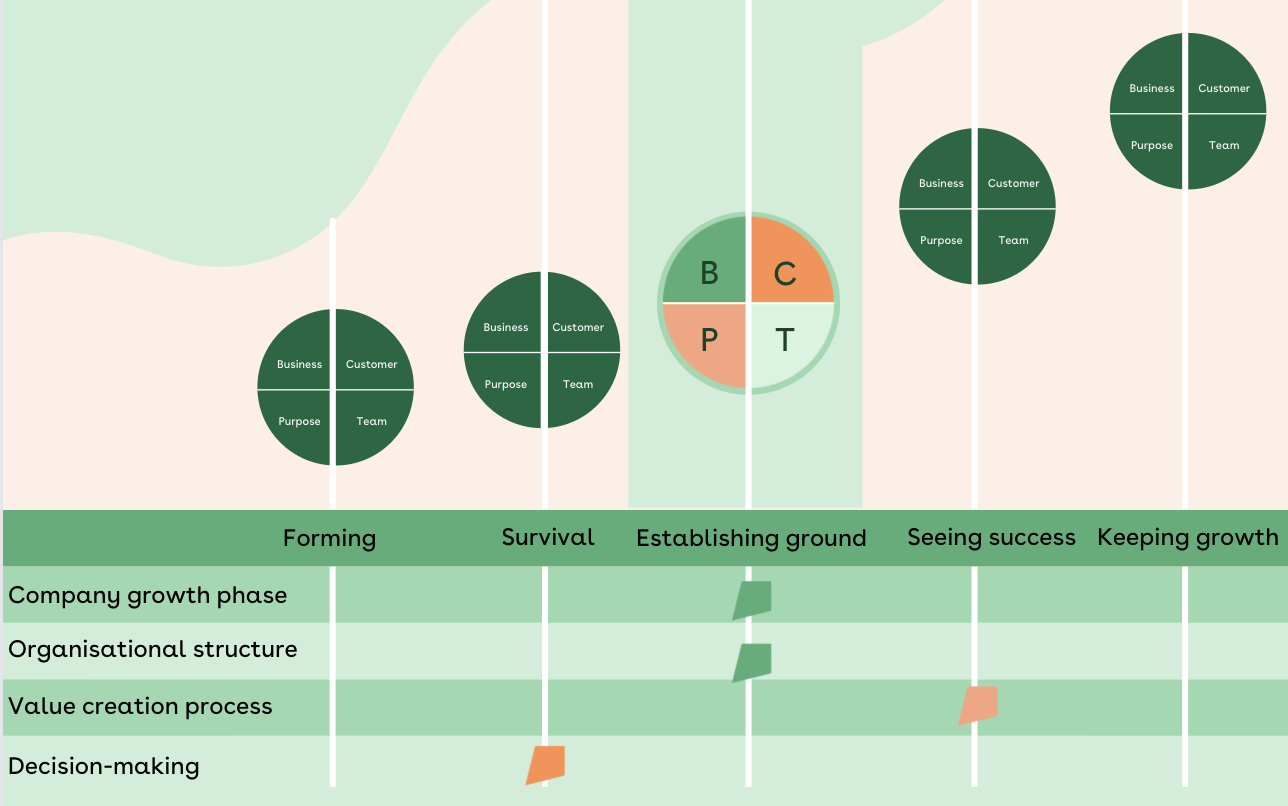Your business is unique, but business growth is not. There are trends, patterns, and common experiences, and we can use this knowledge to our advantage.
Wyseminds combined the lived experience of entrepreneurs who have grown their own businesses with established growth theories (such as Adizes’ Organisations Lifecycles, Greiner’s Growth Curve, and the Stages of Small Business Growth) – and we identified the most important phases of business growth.
5 phases of business growth
These phases are; Forming, Survival, Establishing Ground, Seeing Success, and Keeping Growth. 
But how do you know what phase you are in? Well, each phase is distinguished without any measure to do with size, money, or how long you’ve been in business for – instead, it’s all about your position in the market.
Forming
In this phase you’re just getting started. You (and maybe just a couple of other key partners) are developing your first product/service, and you’re dedicated to proving the need for your new and unique offering.
Survival
In this phase you properly begin to sell. You need to make this work, and as you’re saying yes to every sales opportunity you’re also beginning to improve your offering based on customer feedback.
Establishing Ground
You’ve survived, and now is the time to grow! In this phase you begin to deliver your offering at a larger scale, perhaps with added extras, and your team is developing more defined roles and functions to support this.
Seeing Success
This phase has 3 parts. It begins with a period where you are in a kind of holding pattern – called ‘In Progress’ – where you are well established, with good returns and a healthy market position. But if you want to grow further from here, then it’s usually a choice between two directions;
- Consolidation is where you decide to embed and enhance your offering in your current market. This is a great choice if your existing customer market is able to support your growth ambitions, especially if you want to meet their needs as they change over time.
- Replicating Growth is where you decide to use your existing success as a platform to launch your offering into new markets, territories, or customer groups.
Keeping Growth
By the time you reach this phase you are well established – but having had the reward of many growth moments, the future direction for your business may be a little harder to define, and finding or creating growth opportunities may feel more challenging.
So what?
Ok, that’s interesting enough…but how does this help?
Well different growth phases have different needs. If we understand the patterns of growth we can understand what would best support us for the phase we are in to avoid unnecessary conflict, minimise wasted effort, and to predict the most effective route to take.
Take decision making as an example; how you make decisions as a business will be very different in the keeping growth phase compared to how things were years before in the forming or survival phase – because your needs have changed, and different circumstances need a different approach.
The same principle is true of lots of organisational capabilities – the functions, structures, and skills you need to operate effectively. There are lots of these capabilities (things like project management, financial management, change management, etc) and they’re all useful and important…but…
… some capabilities have a much bigger impact on your growth than others, if you align them to your growth phase. And those are:
- Your decision making process,
- Your organisational structure, and
- Your value creation process.
What we want to see is that these particular capabilities match your current growth phase. Imagine if your decision-making process was so formal and rigid in the early phases of rapid growth that you can’t make the quick decisions you need to respond to new opportunities. Equally, imagine you’re a large and established company, but all the decisions are being made by just the founder like it was back when you had just started up.
This is called misalignment. It’s one of the reasons why businesses struggle, because they have functions, processes, or skills that are over-, or under-, developed for their current needs.
The more you align these capabilities for the phase you are in, the more seamless and efficient your business will be, and the more effortlessly you will move into your next growth phase.
Now what?
So how do I know what my capabilities should look like for my current growth phase? Now we’re asking the right question!
Here’s what you can do:
- For an idea of how these capabilities should change over time, read this article; WTF are Capabilities?
- Take the Growth Evaluation. It’s a free online questionnaire that creates a report tailored to your unique situation, including how aligned your capabilities are.
- Join our entry level Lift-Off programme, which is packed full of value including a business growth workshop, bespoke report about your company and a one-to-one consultation with one of the Wyseminds. Find out more here >
BUT… the most important thing to do now is not get distracted from your purpose. It’s really tempting to dive into processes and systems – hey we’re all process geeks at heart! – but these capabilities are only ever effective if they are in service of your purpose as a business. So always begin with aligning your Powerball (the most important Drivers for growth), and then adapting and changing your capabilities becomes so much easier.

If you’d like to have a call to talk about your company and understand more about the Lift-Off programme and workshops, book a virtual coffee with Julie here.


